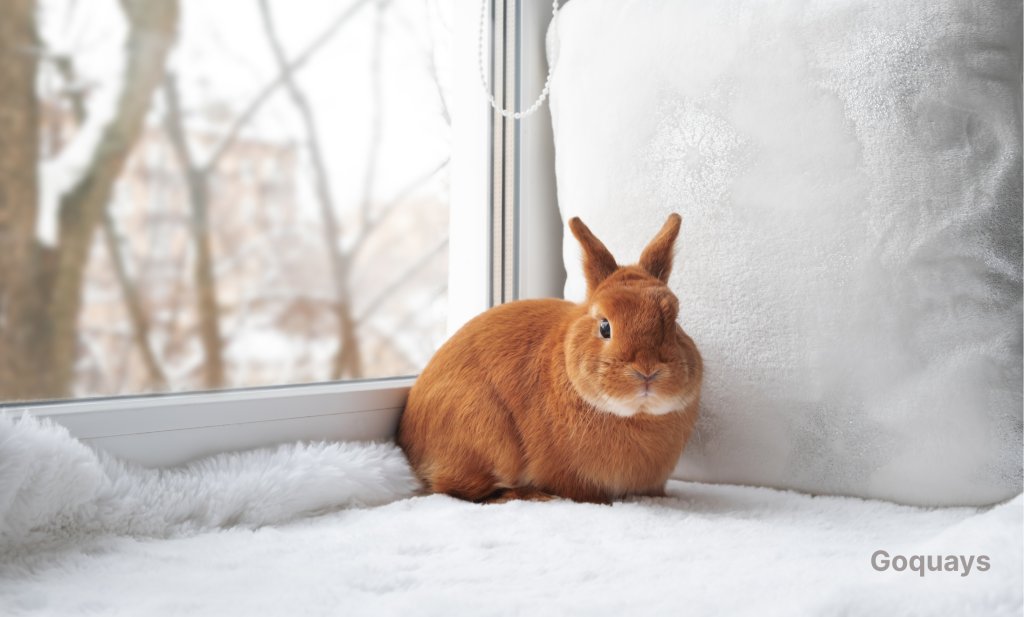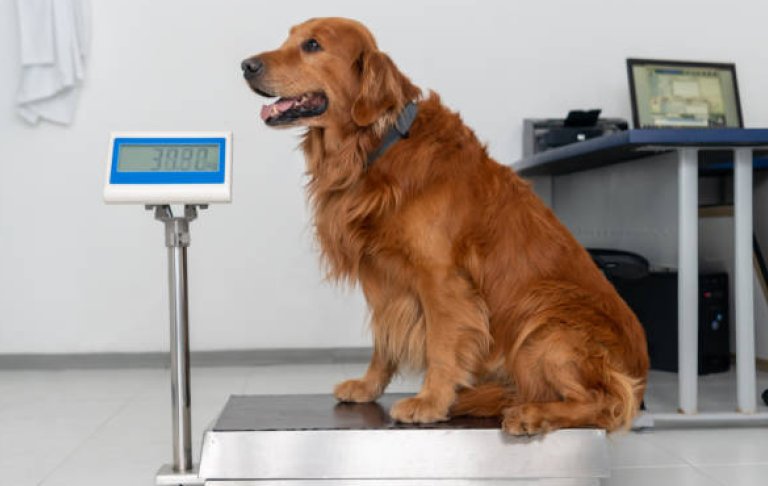Do you imagine a wooden hutch at the back of your house when you think of a pet rabbit? You are definitely not alone. Rabbits have been kept as outdoor pets for many years, hidden away in secluded areas of the yard, away from the warmth they can enjoy indoors. The reality is that in addition to being outdated, outdoor housing can significantly reduce a rabbit’s lifespan.
Rabbits are sensitive, intelligent animals who thrive in situations that are safe and stimulating. Keeping them outside exposes them to a variety of risks, such as neglect, fatal illnesses, predators and harsh weather conditions. Indoor rabbits, on the other hand, live longer, healthier, and more satisfying lives.
Rabbits are very affectionate pets that thrive when given proper care. While traditionally housed outdoors, more pet owners are bringing their rabbits inside, and for good reason as several studies have shown that indoor rabbits tend to live longer, healthier, and happier lives compared to their outdoor counterparts
We’ll look at the actual dangers of outdoor housing and discuss why bringing your bunny indoors is one of the best things you can do for their health. Knowing the difference between indoor and outdoor housing could change your life and the life of your pet. Whether you’re an experienced rabbit owner or thinking about adopting one for the first time.
Benefits of Keeping Rabbits Indoors
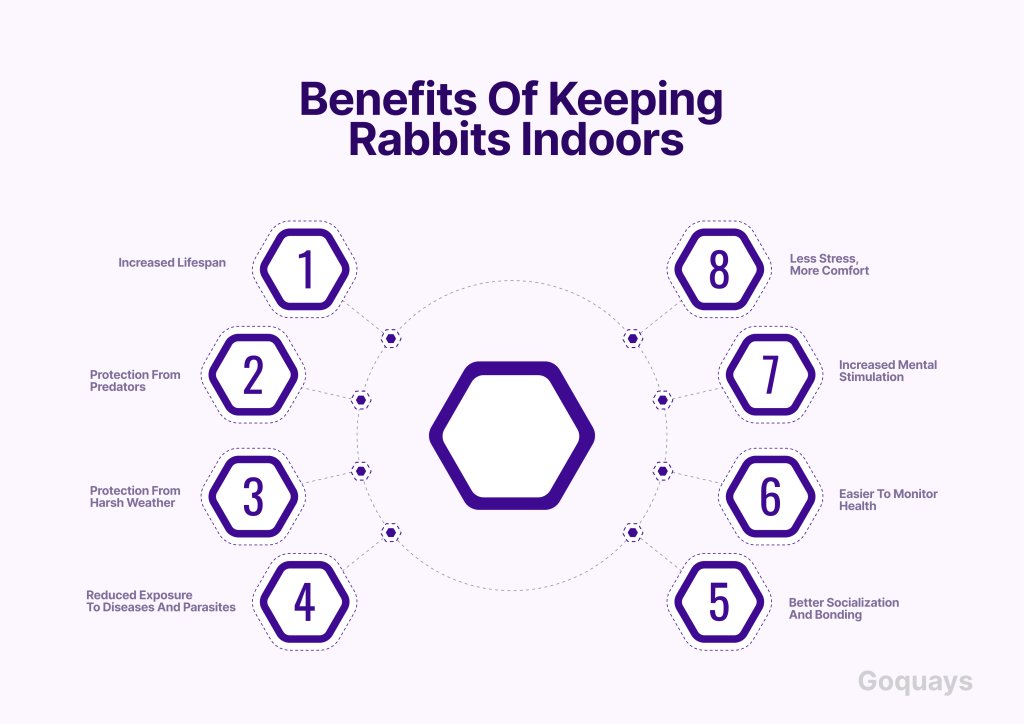
There are several benefits to keeping rabbits indoors that enhance their general well-being, security, and contentment. Although they can live outside, rabbits really flourish when they live with you. Below are some of the compelling reasons why you should consider bringing your bunny inside:
Increased Lifespan
Compared to their outdoor counterparts, indoor rabbits typically have far longer lifespans. Indoor rabbits can live for up to 10-12 years because they are protected from severe weather conditions, and common outdoor diseases. On the other hand, because of the increased hazards in their surroundings, outdoor rabbits might only live for three to six years.
Protection from Predators
Rabbits are prey animals, hence predators like foxes, raccoons, birds, and wild cats and dogs can pose a threat to the survival of a rabbit outdoors, regardless of whether you live in the city or not. After coming into contact with a predator, several rabbits have passed away from stress-induced heart failure rather than physical attacks. Living indoors virtually eliminates this risk.
Protection from Harsh Weather
Rabbits are extremely sensitive to changes in temperature. In hot weather, they are prone to high body temperatures, and in cold weather, they are susceptible to hypothermia. High humidity, wind, snow, and unexpected downpours can all cause major health issues for them. Rabbits have a stable, climate-controlled environment indoors that promotes their health all year long.
Reduced Exposure to Diseases and Parasites
In addition to being more vulnerable to potentially fatal diseases like myxomatosis and Rabbit Hemorrhagic Disease (RHD), outdoor rabbits are also more likely to come in contact with parasites like fleas, ticks, and mites. Vaccinations are beneficial, but keeping your rabbit indoors provides an additional line of defence against these dangers.
Better Socialization and Bonding
As social creatures, rabbits develop close relationships with their human companions. They naturally become more involved in family life when they live indoors. They’ll learn to trust you, seek your attention, and often exhibit more confident and friendly behavior. Even cuddling, watching TV with you, or following you around like dogs do are activities that many indoor bunnies enjoy.
Easier to Monitor Health
When your rabbit lives indoors, you’re more likely to notice subtle changes in their behaviour, appetite, droppings or other early signs of illness. Because rabbits are prey animals, they often hide symptoms until a condition becomes severe.
Increased Mental Stimulation
Indoor rabbits typically have more opportunities for exploration, mental stimulation, and play; access to chew toys, foraging games, and even supervised time in different rooms keeps them active and engaged. Boredom can lead to depression or destructive behaviour, but a stimulating indoor environment helps prevent that.
Less Stress, More Comfort
Rabbits prefer spaces that are safe, peaceful, and comfortable. They can unwind indoors without worrying about strange external sounds, abrupt temperature changes, or exposure to parasites. This lowers their general stress levels, which are strongly associated with improved longevity and immune function.
How to Keep Your Rabbit Safe Indoors?
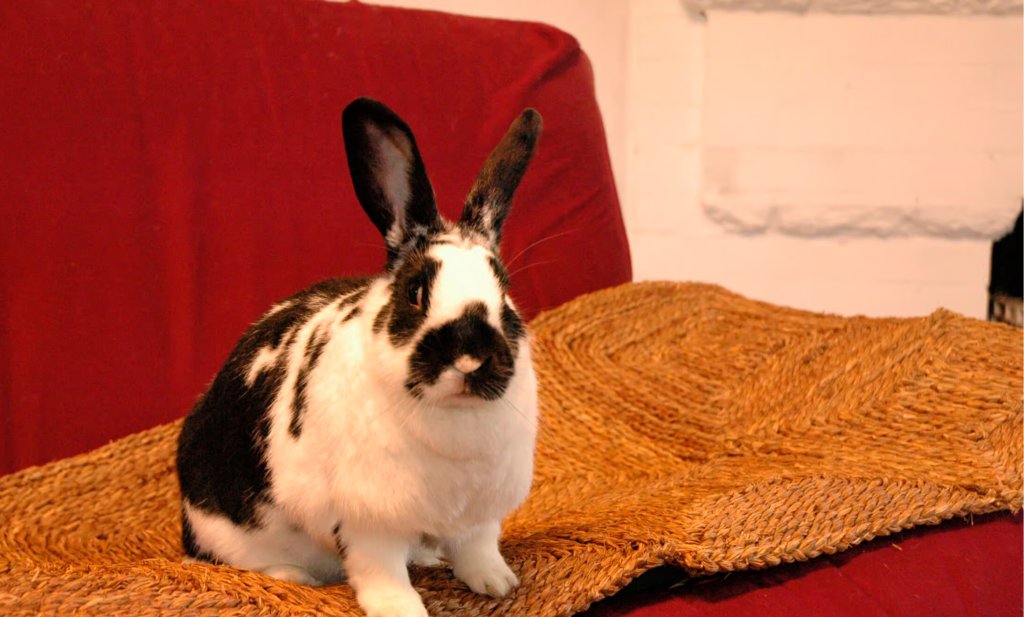
Although bringing your rabbit indoors is a great way to give them a safer, more fulfilling life, it also means taking on the responsibility of ensuring their safety. Everyday objects found in homes can pose a risk to inquisitive bunnies. To keep your rabbit safe, content, and out of danger, you must provide a safe and engaging environment free from electrical cables and poisonous houseplants. Here’s how:
- Rabbit-Proof Your Home
Rabbits enjoy chewing, digging, and exploring, and there are many enticing objects in the home that can be dangerous for rabbits. To protect your bunny so that they are free to roam without getting injured or poisoned, you can do the following:
- Use cable covers or protective tubing to conceal or cover electrical wires.
- Since many common houseplants, such as ivy, lilies and aloe vera, are poisonous to rabbits, remove or keep them in elevated positions where your bunny can’t reach them.
- Keep your rabbit out of tight spaces where it could get hurt or stuck, like behind or beneath furniture.
- To limit access to potentially dangerous places, such as the bathroom, kitchen or stairway, use playpens or baby gates.
- Keep medications and cleaning supplies well out of reach.
Consider it baby-proofing your house, bearing in mind that rabbits are low to the ground and are relentless explorers.
- Create a Designated Bunny Zone
Your rabbit will feel more secure and at ease if you provide them a safe, comfortable area in your house. A space they can consider theirs, much like having their own room. Include the following necessities in your designated space, whether it’s a sizable playpen, a sectioned-off corner, or a dedicated room:
- Soft flooring, such as foam mats or rugs, as hardwood and tile can be slick and painful for joints. Especially as rabbits like to hop.
- A place to hide when they need privacy, such as a wooden hideout, cardboard box, or tunnel.
- A litter box filled with wood pellet or paper-based litter (avoid cat litter that clumps, since this can be dangerous).
- Bowls for food and drink or a rack for bottles and hay.
- Chewables and toys to keep them engaged and entertained.
Many indoor rabbit owners choose a free-roaming setup, allowing their rabbit to move freely around the house as long as the home is properly rabbit-proofed.
- Create an Exercise Routine
Rabbits require at least three to four hours of free-roaming time each day, even in a safe play area. They can hop, explore, and engage in natural behaviours like stretching and burrowing when they are supervised outside of their pen. This is essential for:
- Physical health: Strengthens muscles and prevents obesity.
- Mental stimulation: Destructive behaviour and boredom are decreased.
- Bonding: Assists them in developing a relationship and trust with you.
Try creating an interesting obstacle course with cardboard boxes and tunnels, or scattering some hay or treats for foraging.
- Maintain a Calm and Safe Environment
Rabbits are inherently alert at all times; hence they are easily startled. They can become agitated by loud noises, abrupt movements, and strange smells. The following tips will help you maintain quiet and safe environment:
- Stick to a pattern since rabbits are creatures of habit and feel safer when they know what to expect.
- Avoid loud TVs or music, especially close to their living area.
- Introduce other pets gradually and gently, using barriers and brief, positive sessions
- Keep the Space Clean
The health of your rabbit is greatly dependent on cleanliness:
- Replace the litter completely every two to three days and clean the litter boxes every day.
- Clean the water and food bowls on a regular basis.
- Spot clean their space and give it a thorough cleaning once a week, making sure to include the toys and blankets.
Living in a clean environment lowers the risk of respiratory problems, infections, and flystrike which can happen indoors, though very rare.
- Provide Stimulation and Companionship
Rabbits are one of the pets that you advised to adopt in pairs. When they are bored, it makes them sad and it affects their emotional health. You can also improve the emotional wellbeing of your bunny by doing the following:
- Provide puzzle feeders, cardboard boxes, hay-stuffed toilet paper rolls, tunnels, and safe chew toys to keep your bunny stimulated and active.
- Since rabbits are gregarious and often thrive as pairs, think about adopting a bonded companion rabbit.
- Spend time with them every day; hand-feeding them treats, sitting next to them, or gently petting them to earn their trust. (remember that rabbits have their eyes on the sides of their head and not in front, always approach them from the side, that way they can see your hand before it touches their head)
Your home can become a safe refuge for your indoor rabbit with a little effort and care. You will have a contented, healthy rabbit who reciprocates your affection and devotion.
Difference between rabbits who live indoors and those who live outdoors
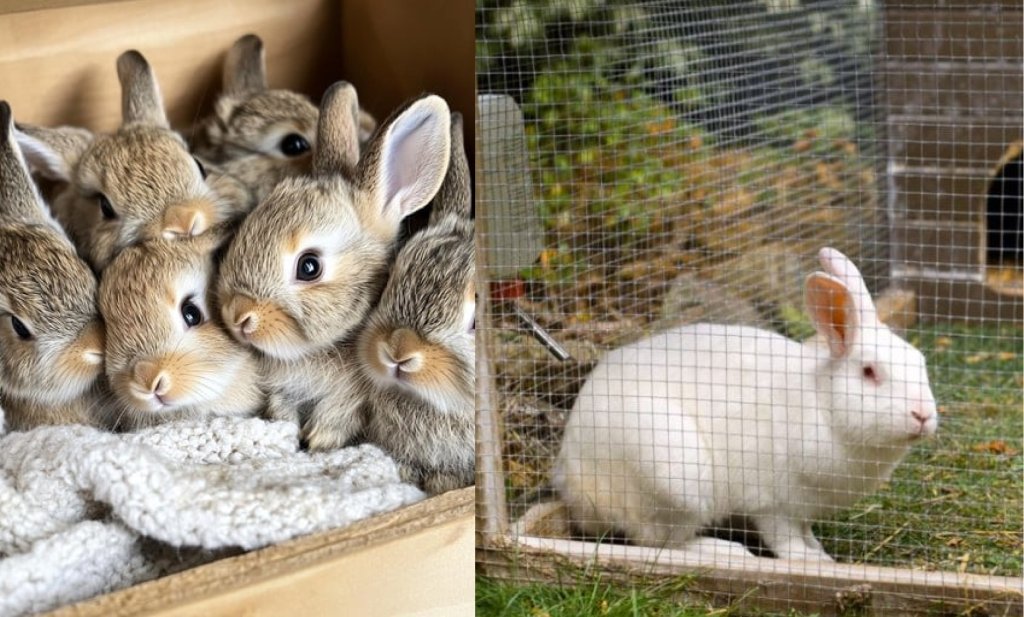
The decision to keep your bunny indoors or outdoors can greatly impact their health, lifespan, and quality of life. Although both settings can provide care and shelter, indoor and outdoor rabbits are exposed to very different conditions, risks, and lifestyles; knowing these differences will help you make decisions that put your rabbit’s welfare first.
Here are the key differences between indoor and outdoor rabbits:
Lifespan
- Indoor rabbits: Usually live 8 to 12 years on average because of a safer, more controlled environment.
- Outdoor rabbits: Usually live 3 to 6 years because of increased exposure to threats like disease, predators, and extreme weather.
The indoor lifestyle offers a degree of safety that greatly lowers early mortality.
Health and Veterinary Care
- Indoor rabbits: are simpler to keep an eye on every day, increasing the likelihood that minor health problems such as, changes in eating pattern, droppings or mobility will be identified early. Quick treatment is often the result of early detection.
- Outdoor Rabbits: Because rabbits can conceal signs of illnesses, their symptoms can go undetected until the ailment worsens or becomes lethal.
Additionally, indoor rabbits are less susceptible to infectious diseases and parasites, which improves their long-term health.
Environmental Exposure
- Indoor Rabbits: enjoy a stable, climate-controlled environment that is free from wind, snow, rain. Living in the house with you protects them from extreme temperatures.
- Outdoor Rabbits: are susceptible to severe cold, heat, precipitation, and abrupt weather changes, which can cause respiratory problems, hypothermia, and heatstroke.
A rabbit cannot be completely shielded from the stress of continuous environmental change by even the best-insulated hutch.
Safety from Predators
- Indoor Rabbits: are protected from predators such as foxes, wild dogs or cats, and preying birds.
- Outdoor Rabbits: Even if a predator is unable to enter the hutch, the anxiety alone can result in stress-induced death for outdoor rabbits, who are always vulnerable to predator assaults or the psychological trauma of being stalked or terrified.
Living outdoors can expose rabbits to stress on a daily basis, which is one of the main silent killers of these animals.
Socialization
- Indoor Rabbits: are better socialized and find it easier to bond with humans. They show affection, are able to engage with people and can even pick a trick or two.
- Outdoor Rabbits: Due to their limited daily interaction, outdoor rabbits have a tendency to be more solitary and less gregarious. They remain timid or uneasy.
Rabbits benefit from increased trust, companionship, and mental stimulation when they live in the home.
Mental Stimulation and Enrichment
- Indoor Rabbits: Have access to a broader range of toys, puzzles, and human interaction, which prevents boredom and destructive tendencies.
- Outdoor Rabbits: If kept alone or in a simple hutch arrangement, they may become easily bored in the absence of frequent stimulation.
Indoor rabbits typically have more interesting and fulfilling lives, and their mental health is equally as vital as physical health.
Hygiene
- Indoor Rabbits: live in areas that are simpler to maintain in terms of cleanliness, hydration, and pest-free conditions.
- Outdoor Rabbits: Especially during bad weather, these animals may have hygiene issues because of damp bedding, insect infestations, or unclean hutches.
A rabbit’s health is directly impacted by cleanliness. It is easier to maintain hygienic conditions when your bunny lives indoors.
Training and Routine
- Indoor Rabbits: They can be litter trained and will easily pick up household routines, like when it’s time for feeding or run to the door when you get home from work.
- Outdoor Rabbits: They typically don’t benefit from as much structure, and there aren’t many opportunities for training.
Training improves your rabbit’s cognitive abilities and strengthens your relationship with them.
Summary Table: Indoor Vs Outdoor Rabbits
Category | Indoor Rabbits | Outdoor Rabbits |
Lifespan | 8-12 years | 3-6 years |
Exposure to predators | None | High |
Temperature Control | Stable regulated temperatures | Exposed to extreme weather conditions |
Health Monitoring | Easy to monitor due to daily observation | Difficult to detect health issues |
Socialization | High, easily blends into family | Low, can be cranky due to less human interaction |
Mental stimulation | High due to exposure to toys and interaction | Low |
Training potential | High, can learn routines and how to use a litter box | Low |
Cleanliness | Easier to maintain hygiene | Poor hygienic conditions |
It is evident from the side-by-side comparison of the two housing styles that your rabbit will lead a safer, healthier, and more interesting life in indoor housing. Though it is possible for rabbits to live outdoors with diligent care, the advantages of having a rabbit as a member of your indoor family greatly exceed the drawbacks.
Conclusion
Your rabbit depends solely on you for its safety and wellbeing. By opting to keep your bunny indoors, you’re offering them not just a longer life, but a better life. Indoor housing is the humane and wise choice for any bunny owner, offering everything from warmth, affection and predator protection to enhanced bonding and proper health monitoring.

